
|

|
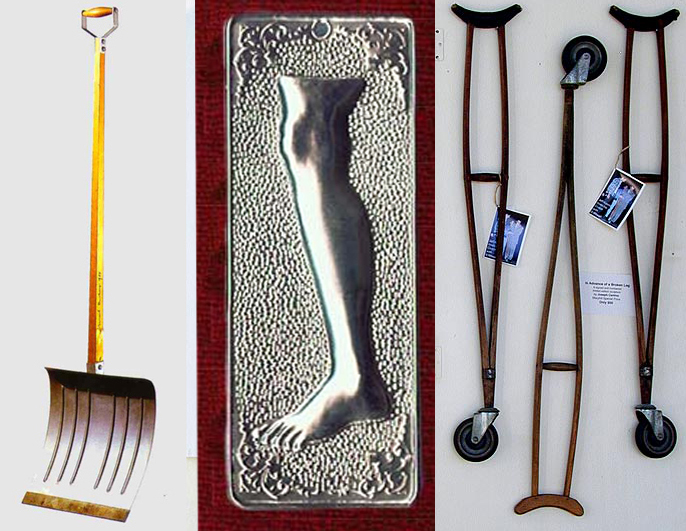
Introduction
by Deanna Sirlin Editor-in-Chief The Art Section
In Advance of the Broken Leg
Zaha Hadid has been on my mind for a few decades. I am always initially attracted to the ways she crosses the liquid boundaries
between architecture, art, and design in her work. I am also attracted to her fearless use of technology to create her work.
The first show I saw of hers was in London at the ICA in 2000, when high-tech computer visualization was fairly new. At that
time, she showed her curvilinear architecture presented by models and animations as the main part of the exhibition along
with early paintings and drawings. Her Venice installation this summer was presented by David Gill Galleries in the Scuola
dei Mercanti, a Gothic building. One came out of the scorching bright heat of mid-day Venice into the dark building. The upstairs
space, painted black, created a highly a theatrical backdrop to her work. In London this past fall, she showed the same installation
in a white cube of a gallery with pristinely painted walls and floors. I am delighted that Venetian videographer Daniele Frison
has taken his eye to the Venice version of this installation for The Art Section.
My relationship to Gilbert and George has been different. I have known of these artists’ collaborative works since the
late 80’s, but they had been working together for decades before that. I only became aware of their early performative
videos after seeing a work in Panic Attack! Art In the Punk Years at the Barbican Gallery (London, UK) this past summer.
Their piece in this exhibition, entitled The World Of Gilbert and George (1981), shows rare footage of the artists’
performances. I cannot help but think of the many collaborative artist teams who have been influenced by Gilbert and George:
The Art Guys, the Starn Twins, and Komar and Melamid, to name but a few. The Art Section’s critic and resident composer,
Guisseppe Gavazza, was moved to create his own composition in response to Gilbert & George: Major Exhibition which
he experienced Castello di Rivoli in Turin. This exhibition was first shown at the Tate and has traveled to Haus der Kunst
Munich (June to September 2007) and Castello dei Rivoli, Turin (October 2007 to January 2008). This exhibition will then travel
to The De Young Museum, San Francisco (February to May 2008), the Milwaukee Art Museum (June to September 2008), and the Brooklyn
Museum of Art (October to January 2009).
Juxtaposed with this artistic commentary by our correspondents we have we have performance critic Jon Erickson on the subject
of experimentation in science and art. As for me, I am reflecting on my broken ankle as I swivel around in this wheelchair,
thinking about healing and how this will all influence me. I have often been thinking about Duchamp and his work from 1915,
In Advance of the Broken Arm--and what his counterpoint might be for a leg….but here is my tribute,which is
a sort of combine.
Thank you.
www.deannasirlin.com
A Video Essay on Zaha Hadid's Dune Formations in Venice
by Daniele Frison
Music by Claudio Ambrosini
Please click on the image below to view the video.
Windows Users: To watch the video, you will
need Quicktime for Windows. If you do not have it, you may download it by clicking here.

|
| Zaha Hadid's Dune Formations in Venice, Italy (2007). Video Still: Daniele Frison. |
Daniele Frison is a videographer
who lives and works in Venice, Italy.
www.danielefrison.com
Composer Claudio Ambrosini is
the founder of the Ex Novo Ensemble of Venice, which is dedicated to contemporary music, and won a Golden Lion for Music of
the Present at the 51st International Festival of Contemporary Music in 2007.
http://www.exnovoensemble.it
http://www.labiennale.org

|
| David Tudor performs John Cage's 4'33" in 1952. |
The Use and Abuse of the Term "Experimental" in Art and Performance
by Jon Erickson
What we
call the modern age, whether we date it from the nineteenth century or the Renaissance, seems virtually coterminous with the
word “experiment.” That is, the authority of tradition is called into question by the testing of concepts against
their putative basis in the real world. While seemingly confined to the sphere of science, it spread to every other aspect
of cultural life, and we define the modern by the continual shifts of our bases of understanding by the ethos of experimentation.
What’s more, this ethos requires an atmosphere of freedom within which to manifest its practice and at the same time
presumably functions as a way in which freedom is itself propagated or maintained through challenging the status quo.
In a scientific sense, “experiment” is tested against the conditions of physical reality until the consistency
of cause-and-effect becomes relatively immutable, or eminently replicable. In an artistic sense “experiment”
is tested against the human reality of audiences, a reality, as many social scientists understand, that is far less stable
in its capacity for yielding stable results. Artistic results depend upon two factors, it would seem, for the audience: 1.
understanding the experiment, and 2. appreciating the results of the experiment. Often, these two aspects are conflated,
typically by the artist or critic, so that if the audience didn’t appreciate the experiment, they couldn’t have
understood it, which may or may not be true. From the audience perspective, an experiment that is understood but not appreciated
is a failed experiment. There is also the middle ground where the premise of an experiment might be appreciated, but not
its realization. There is also the possibility that one might be able to appreciate something, to have it affect one, without
necessarily understanding it, though this effect tends to be somewhat rare. Yet one might conclude that this effect is representative
of the most important works. What is missing from the above comparison between scientific and artistic experimentation is
the nature of the expected results, found in the vagueness of the term “appreciation.” In one case the result
is a certain referential truth-value that can obtain in law-like form, in the other an affective value that incorporates a
different sense of “truth” with regard to recognizable but variable human experience.
In artistic work, a defensive pre-emption of possible criticism can come along with a certain usage of the word “experimental,”
as a way of indicating that typical norms of evaluation, and sometimes any existing norms of evaluation, cannot be used in
interpreting or judging the work performed. Indeed the experimental work is sometimes touted as a fundamental challenge to
normative evaluation itself.
For scientists, even social scientists, most experiments - that is, most testing of certain hypotheses - fail, and they are
understood as failures. But the reworking of the hypothesis toward a successful series of testings of it depends upon those
initial failures as modes of clarification. Even the most unsuccessful of artistic productions can contain within them some
germ of value that I can carry away with me, that keeps me thinking about the performance context and its meaning. But this
doesn’t mean I’m not still evaluating the experience as a whole as successful or not, or thinking of how that
germ could have been grown into something more developed and powerful.
Reasons for failure are worth considering, as much as reasons for success. But the artist needs an evaluating audience for
this: it is not something one can decide on one’s own – if so, one has created a solipsistic fantasy world in
which the decision for what “works” and what doesn’t is completely arbitrary. And one has to admit that
experiments can fail, and that “experimental” is not the complete suspension of the process of evaluation of ends,
so that every experiment, no matter what, succeeds, regardless of its reception.
In one sense every performance is an experiment. But typically speaking, a performance that has relatively clear meaning structures,
however complex, that anticipates a particular range of responses, and that is possibly developed with respect to those responses,
is not “experimental” if the artist involved claims that the work has failed or succeeded with regard to the audience.
Intention clearly plays a part. Brecht, for instance, for his political purposes, took experiments with audience reception
seriously: if they didn’t “get it,” he felt he had to make it clearer – this is not using “experiment”
as a mode of superior knowledge that blames the audience for its lack of understanding. Presumably – and art history
is full of such examples – performances can fail with audiences and yet succeed with critics, theorists and historians.
Typically speaking, what succeeds in this sense is not the performance but the concept implied in the performance. The concept
could even be lost on its audience and yet continue to exert a conceptual influence elsewhere.
I think, for example, of Cage’s “silent piece,” 4’33”. According to Cage’s own
retrospective myth of its premiere in Woodstock, New York in 1952, the audience, made restless by David Tudor’s refusal
to actually play the piano at which he was sitting, was finally able to open its ears to the ambient sound of the hall and
the outside noises filtering in through the windows and understand that as the “music”. That this is what the
audience actually experienced, as opposed to seeing it, for instance, as a Dadaistic send-up of concert decorum, signaled
by Tudor’s visible behavior, is completely open to question. That the piece made an impression on the audience, I
have little doubt, but the subsequent conceptual meaning given the piece wasn’t necessarily a consequence of the performance’s
actual reception by that audience. It was a meaning given to it by Cage and accepted as such thereafter. In fact, the
meaning given to this experience, even if imposed retrospectively, isn’t false in general, even if it might be false
in terms of the original audience’s actual experience, because it is subsequently validated by further works of Cage
in which he instructs the audience to listen to ambient sound, and it is the most powerful and important lesson I’ve
ever gotten from Cage myself.
In thinking about experimental performance, despite the artist-centered nature of the idea, the question of audience nonetheless
remains central in assessing its meaning. Can an experiment be successful for an artist but not for an audience? Can an experiment
be “successful” for an audience but not for an artist? Is an experiment successful if it doesn’t affirm
the artist’s expectations, but creates a very different kind of result? If that result is pleasing, is it a success?
If it is displeasing is it a failure? Is an experiment a failure if it does affirm the artist’s expectations and teach
her nothing new?
The experimenter who stands aloof of his artistic experiment is not really experimenting at all, since self-knowledge is not
put at risk. It is cynical manipulation of the na´ve. If an experiment is not designed to advance the self-reflection or
thinking of the artist it is not an experiment at all; the term then becomes an excuse to avoid the responsibility for one’s
acts. Foucault once made the point that all real thinking is dangerous, but it is not merely dangerous to others (the more
glib practices of “subversion”) but dangerous to oneself: it could lead to greater doubt, even despair, or it
could lead to a state of greater enlightenment, or through one, the other.
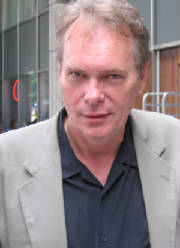
Jon Erickson teaches drama and performance in the English Department at
the
Ohio State University.
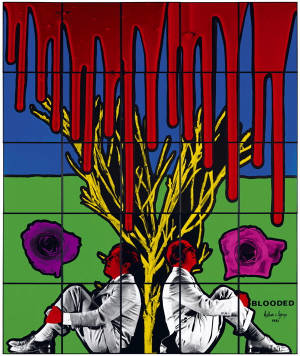
|
| Gilbert and George, Blooded (1983). Courtesy: Tate Modern. |
Pictures of an Exhibition:
listen to the show
Gilbert & George: Major Exibition at Castello di Rivoli,
Museum of Contemporary Art, Turin
by Giuseppe Gavazza
I borrow the title "Listen to the show" from the exhibition I reported on last month for The Art Section.
Gilbert & George aren’t my favorite artists, starting with their slogan: Art for all.
Not really for me.
In any case, this major exhibition at the Castello di Rivoli Museum in Torino is, as we can read, "the most extensive retrospective of their
art that has been organized to date."
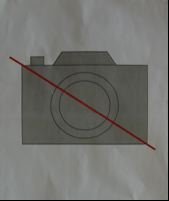 So, I cannot avoid visiting it, exploring the 127 works in the 23 rooms on the second
and third floors of the Rivoli Museum. As I am involved in sound and the use of any visual recorder (camera or video camera)
is forbidden - as usual – in the museum but audio recorders are permitted, I moved through the entire exhibit, room
by room as an iPodded walk-man, armed with my digital audio tool (recorder, microphones and headphones). I now present to
you my audio reportage.
Please click on the five images below to visit listening to the show, using the maps and the 5 scores-timelines (there you
can see the titles and the thumbnails for all the works of the show) for your 45-minute, imaginative acoustic trip: my voice
will announce, room by room, the titles of the exhibited G&G works as I was just in front of them.

Enjoy your visit.
I certify that this recording was made on Sunday October 28th 2007, from 2:42 p.m. till 3:27 p.m. I declare as well that the
audio files here presented in 5 sections correspond to the full, real-time, whole recording of my visit to the exhibit, with
no post editing.
Recorded with a ZoomH4 SD Card digital recorder, embedded microphones, limiter on, original file mp3, 112 K, constant bit
rate, stereo, 44.1Khz.
Torino, October 31 2007
Please click on each of the images (scores) below to hear the corresponding audio.
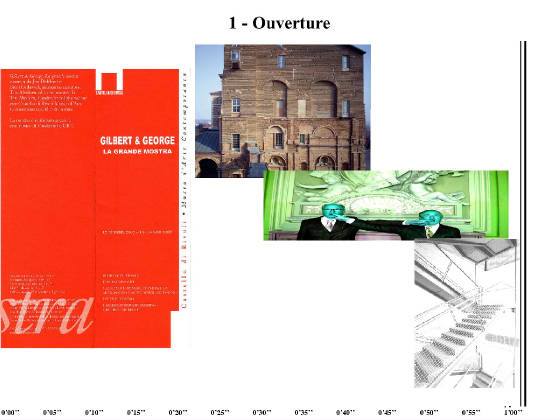
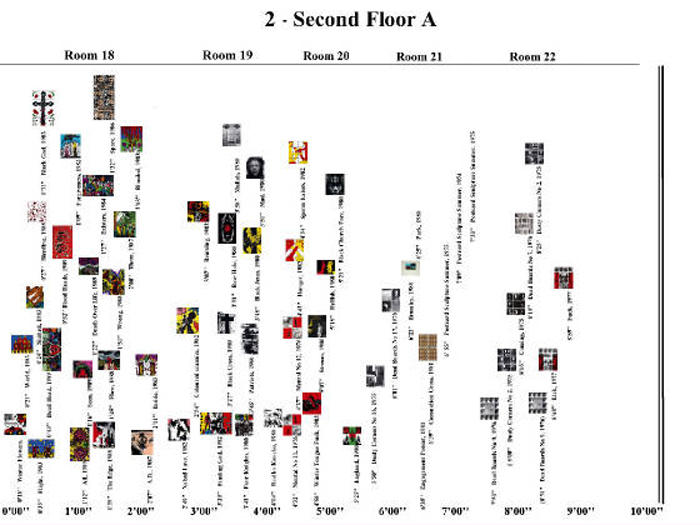
To see a larger version of this image, please click here.
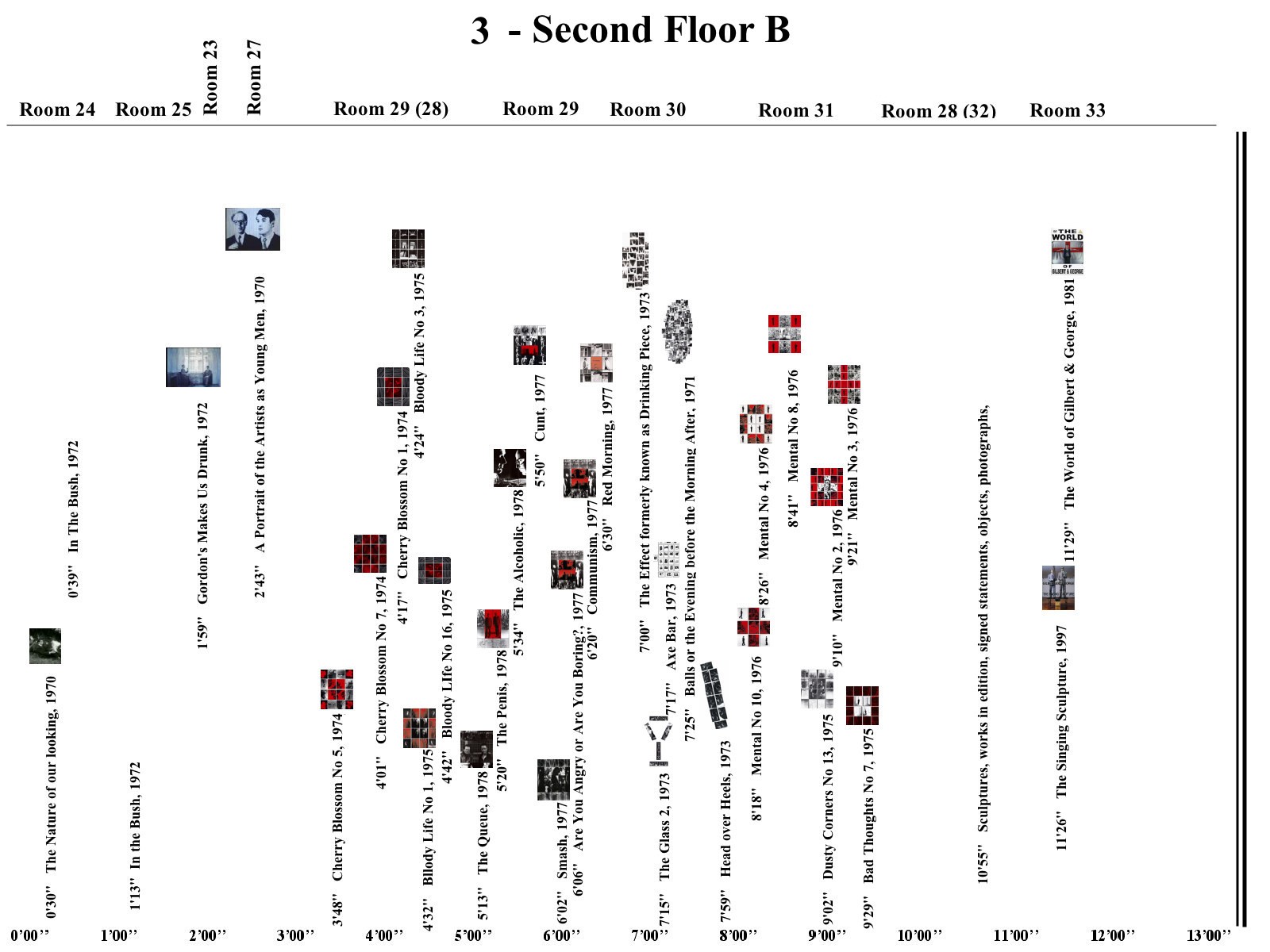
To see a larger version of this image, please click here.
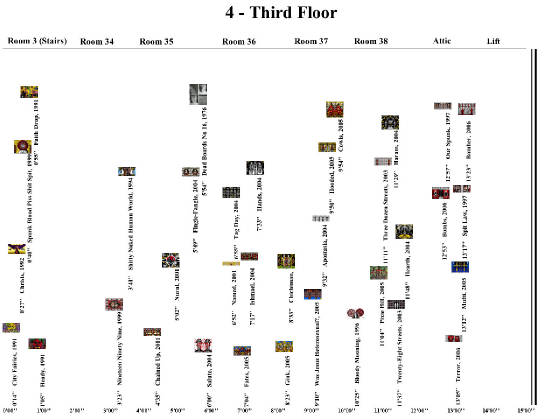
To see a larger version of this image, please click here.
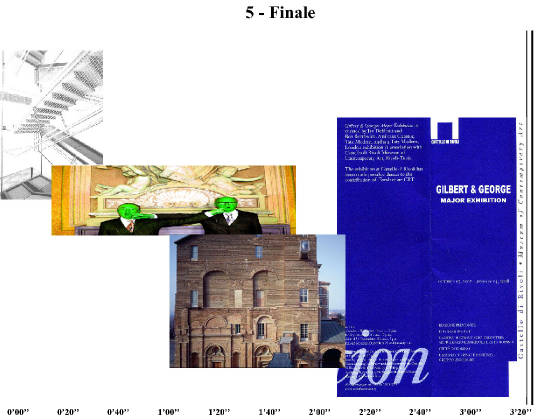
Giuseppe Gavazza is a composer who lives and works in Turin, Italy.
www.giuseppegavazza.it
|

|

|


